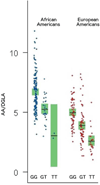Gamma-linolenic acid, Dihommo-gamma linolenic, Eicosanoids and Inflammatory Processes
- PMID: 27083549
- PMCID: PMC4975646
- DOI: 10.1016/j.ejphar.2016.04.020
Gamma-linolenic acid, Dihommo-gamma linolenic, Eicosanoids and Inflammatory Processes
Abstract
Gamma-linolenic acid (GLA, 18:3n-6) is an omega-6 (n-6), 18 carbon (18C-) polyunsaturated fatty acid (PUFA) found in human milk and several botanical seed oils and is typically consumed as part of a dietary supplement. While there have been numerous in vitro and in vivo animal models which illustrate that GLA-supplemented diets attenuate inflammatory responses, clinical studies utilizing GLA or GLA in combination with omega-3 (n-3) PUFAs have been much less conclusive. A central premise of this review is that there are critical metabolic and genetic factors that affect the conversion of GLA to dihommo-gamma linolenic acid (DGLA, 20:3n-6) and arachidonic acid (AA, 20:4n-6), which consequently affects the balance of DGLA- and AA- derived metabolites. As a result, these factors impact the clinical effectiveness of GLA or GLA/(n-3) PUFA supplementations in treating inflammatory conditions. Specifically, these factors include: 1) the capacity for different human cells and tissues to convert GLA to DGLA and AA and to metabolize DGLA and AA to bioactive metabolites; 2) the opposing effects of DGLA and AA metabolites on inflammatory processes and diseases; and 3) the impact of genetic variations within the fatty acid desaturase (FADS) gene cluster, in particular, on AA/DGLA ratios and bioactive metabolites. We postulate that these factors influence the heterogeneity of results observed in GLA supplement-based clinical trials and suggest that "one-size fits all" approaches utilizing PUFA-based supplements may no longer be appropriate for the prevention and treatment of complex human diseases.
Keywords: Arachidonic acid; Dihommo gamma-linolenic acid; Eicosanoid; Gamma-linolenic acid; Inflammation.
Copyright © 2016 Elsevier B.V. All rights reserved.
Conflict of interest statement
Floyd H. Chilton is a paid consultant for Eagle Wellness, LLC. This information has been revealed to Wake Forest Baptist Medical Center and is institutionally managed. Other authors have no conflict of interest.
Figures
References
-
- Amagai Y, et al. Dihomo-γ-linolenic acid prevents the development of atopic dermatitis through prostaglandin D1 production in NC/Tnd mice. J Dermatol Sci. 2015;79:30–37. - PubMed
-
- Andreassi M, et al. Efficacy of gamma-linolenic acid in the treatment of patients with atopic dermatitis. J Int Med Res. 1997;25:266–274. - PubMed
-
- Ariel A, Serhan CN. Resolvins and protectins in the termination program of acute inflammation. Trends Immunol. 2007;28:176–183. - PubMed
Publication types
MeSH terms
Substances
Grants and funding
LinkOut - more resources
Full Text Sources
Other Literature Sources
Research Materials



